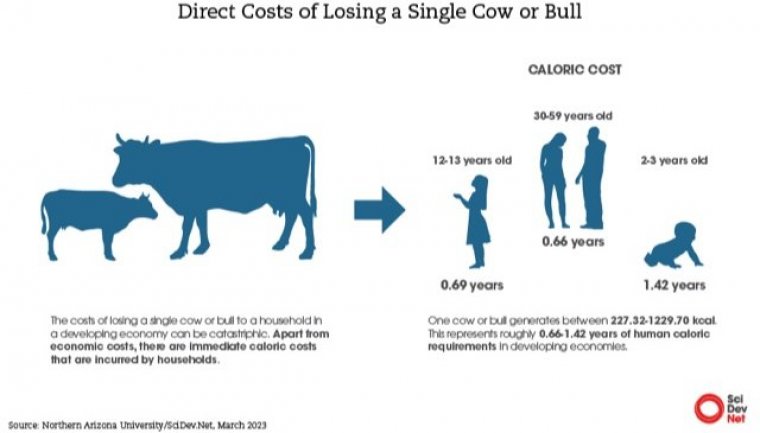| News / World News |
World’s big carnivores take toll on poorest communities
Poorer, rural communities pay the highest price for living with large, carnivorous wild animals such as lions and tigers, according to research which calls for more support for those at the sharp end.

Poorer farmers ‘more economically vulnerable’ to cattle loss from wild carnivores. Photo: SciDev.Net
Conflict between people and animals is one of the biggest threats to the long-term survival of some of the world’s most prized species. But it also has significant economic implications and food security risks for the cattle keepers they live alongside, say the researchers.
Livestock losses resulting from carnivorous predators places increased costs on already impoverished households.
Alex Braczkowski, a research fellow at Griffith University in Australia and lead author of the study, says developing countries such as Kenya, Uganda or India suffer roughly an eight times higher economic vulnerability to human-wildlife conflict—with respect to cattle farmers—compared to wealthier countries such as Sweden, Norway, or the US.
“What these results show is that the most vulnerable economic communities on Earth live alongside carnivores and pay the highest price for human-wildlife conflict,” said Braczkowski.
“We have to ask ourselves: what mechanism—financial or other—can we put in place to aide these communities, especially where national park revenue sharing, or other economic benefits cannot be accrued by the people living alongside carnivores?”
The researchers looked at 133 countries at different stages of development which are home to 18 large carnivores known to prey on cattle. They analysed per capita income together with cattle prices to calculate the value of a single cow and the impact of losing it, to farmers in different locations.
Farmers from the global South are often the ones paying the price for living alongside species such as lions, tigers, wolves, or bears—animals which people worldwide believe should be conserved for their intrinsic value, the study said.
For many farmers, an animal represents the key—if not the only—source of income, and loss to a predator can be economically disastrous.
In developing countries, cattle keepers also produce almost a third less meat per animal on average compared to those in developed economies, the researchers found.
A single cow lost to a wild animal in the lowest-income areas is nearly equivalent to 18 months of lost calories by a child, according to the analysis.
Duan Biggs from Northern Arizona University’s School of Earth and Sustainability and senior author of the study, says the research illustrates how rural people in lower-income countries bear the biggest burden of conservation. “Our study… quantifies it in a way that has never been done before,” he told.
Biggs challenges the global conservation community do more to address the inequalities. The paper calls for mechanisms to be developed for rich countries to make payments to the communities at risk.
“We need to realise that the systems we have in place, working through largest established NGOs, multinational corporations and consultancy firms, often leads to very little trickling down to the people on the ground. We need to really do things differently now that we have the technology that can bring efficiency,” said Biggs.
Peter Kasinigi, a conservationist with Shompole conservancy in Kajiado in Southern Kenya, says the research is timely and highlights what communities living with wildlife have long been agitating for.
“The Maasai community has lived side by side with wildlife for centuries, but it’s only recently that we have learnt the value of conserving wildlife,” he told.
He said one of the rites of passage among the Maasai community was for a moran (man) to open the mouth of a lion—which means killing the animals.
“As a community we have since reviewed this requirement for a rite of passage because we recognise that we need our wild animals for posterity,” he added.
Peter Lindsey, Zimbabwe-based director of the Wildlife Conservation Network’s Lion Recovery Fund, who did not participate in the research, believes the study makes a valid point that developing economies bear a disproportionate burden from human-wildlife conflict.
“Many developing countries also make disproportionate sacrifice in terms of effort to conserve megafauna (large roaming animals) by establishing very large protected area networks. This needs to be recognised,” he said. (SciDev.Net)
YOU MAY ALSO LIKE





